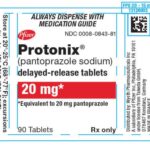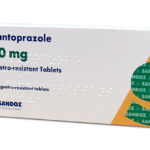How Long Does Pantoprazole Take To Work

Pantoprazole, sold under the brand name Protonix among others, is a medication used to treat damage from gastroesophageal reflux disease (GERD), a condition in which backward flow of acid from the stomach causes heartburn and possible injury of the esophagus (the tube between the throat and stomach) in adults and children 5 years of age and older.
Pantoprazole is used to allow the esophagus to heal and prevent further damage to the esophagus in adults with GERD. It is also used to treat conditions where the stomach produces too much acid, such as Zollinger-Ellison syndrome in adults. Pantoprazole is in a class of medications called proton-pump inhibitors. It works by decreasing the amount of acid made in the stomach.
How Does Pantoprazole Work?
Proton pump inhibitors like pantoprazole block a chemical system in the body called the hydrogen-potassium adenosine triphosphatase enzyme system, also known as the proton pump. These proton pumps line the stomach and are responsible for the production of hydrochloric acid, which is one of the main components of stomach acid. Proton pump inhibitors work by stopping the cells in the lining of the stomach from producing too much acid. When the amount of acid in the stomach is reduced, existing ulcers have a chance to heal, new ulcers are prevented from forming, and acid reflux symptoms, such as heartburn and regurgitation, are reduced.
How should I use pantoprazole?
Each tablet contains 20mg or 40mg of pantoprazole. You can buy pantoprazole 20mg tablets from pharmacies. These are suitable for the short-term treatment of heartburn and acid reflux in adults.
Liquid pantoprazole can be prescribed for people who cannot swallow tablets. It will come with a syringe or spoon to help you take the right amount. If you don’t have a syringe or spoon, ask your pharmacist for one.
The usual dose to treat:
• heartburn and acid reflux is 20mg a day
• gastro-oesophageal reflux disease is 20mg to 40mg a day
• stomach ulcers is 20mg to 40mg a day
• Zollinger-Ellison syndrome is 40mg to 80mg a day – this can increase to 160mg a day depending on how well it works for you.
Will my dose go up or down?
Sometimes your doctor will increase your dose of pantoprazole if it isn’t working well enough.
Depending on the reason you take pantoprazole, you may take a higher dose to begin with, usually for a month or two. After this, your doctor may recommend that you take a lower dose.
How long will I take it for?
If you buy pantoprazole from a pharmacy, you can usually take it for up to 2 weeks.
After 2 weeks:
• if your symptoms have improved – you can take it for another 2 weeks
• if your symptoms have not improved – or they are worse, speak to a doctor before taking any more pantoprazole
Do not take pantoprazole for more than 4 weeks without speaking to your doctor first. If your symptoms have not improved, you may need some tests to find out what’s causing them.
If you take it on prescription, you may only need to take it for a few weeks or months, depending on your illness. Sometimes your doctor may advise you to take it for longer, even for many years.
Your doctor may suggest taking pantoprazole only when you have symptoms. This means you won’t have to take it every day. Once you feel better, you can stop taking it – often after a few days or weeks. Taking pantoprazole this way isn’t suitable for everyone. Speak to your doctor about what’s best for you.
What if I forget to take it?
If you usually take it:
• once a day – take the missed dose as soon as you remember, unless your next dose is due in less than 12 hours in which case skip the missed dose. Take your next dose at the usual time, and then carry on as normal.
• twice a day – take the missed dose as soon as you remember, unless your next dose is due in less than 4 hours in which case skip the missed dose. Take your next dose at the usual time, and then carry on as normal.
Never take a double dose to make up for a forgotten dose. If you often forget doses, it may help to set an alarm to remind you. You could also ask your pharmacist for advice on other ways to remember your medicine.
What if I take too much?
It is very unlikely that taking one or two extra doses will cause any problems. However, you should check with your doctor if you have taken too much and have any of these symptoms:
• flushed skin
• feeling sweaty
• a fast heartbeat
• feeling sleepy
• blurred vision
• feeling confused or agitated
How Long Does Pantoprazole Take To Work?
Generally, after taking pantoprazole you should start to feeling better within 2 to 3 days, although, it may take up to 4 weeks for pantoprazole to work properly so you may still have some symptoms during this time.
What are the side effects of pantoprazole?
Common side effects of pantoprazole include:
• Headache
• Abdominal pain
• Facial puffiness
• Generalized swelling (edema)
• Chest pain
• Diarrhea
• Constipation
• Itching
• Rash
• Gas
• High blood sugar (hyperglycemia)
• Nausea
• Vomiting
• Photosensitivity
Other side effects of pantoprazole include:
• Skin swelling
• Atrophic gastritis
• Anterior ischemic optic neuropathy
• Hepatocellular damage leading to hepatic failure
• Interstitial nephritis
• Pancreatitis
• Low white blood cell, red blood cell, and platelet count
• Muscle wasting (rhabdomyolysis)
• Risk of a severe allergic reaction (anaphylaxis)
• Stevens-Johnson syndrome
• Fatal toxic epidermal necrolysis
• Erythema multiforme
Postmarketing side effects of pantoprazole reported include:
• Weakness
• Fatigue
• Feeling unwell (malaise)
• Hepatocellular damage leading to jaundice and hepatic failure
• Agranulocytosis, pancytopenia
• Taste disorders (loss of taste, changes in taste)
• Weight changes
• Low blood sodium (hyponatremia)
• Low blood magnesium
• Bone fracture
• Hallucinations
• Confusion
• Insomnia
• Drowsiness
• Interstitial nephritis
• Severe dermatologic reactions (some fatal), including erythema multiforme, Stevens-Johnson syndrome, and toxic epidermal necrolysis (some fatal), as well as angioedema (Quincke edema)
• Cutaneous and systemic lupus erythematosus
• Cyanocobalamin (Vitamin B-12) deficiency
• Clostridium difficile-associated diarrhea
This document does not contain all possible side effects and others may occur. Check with your physician for additional information about side effects.
Ask your pharmacist or doctor for a copy of the manufacturer’s information for the patient.





